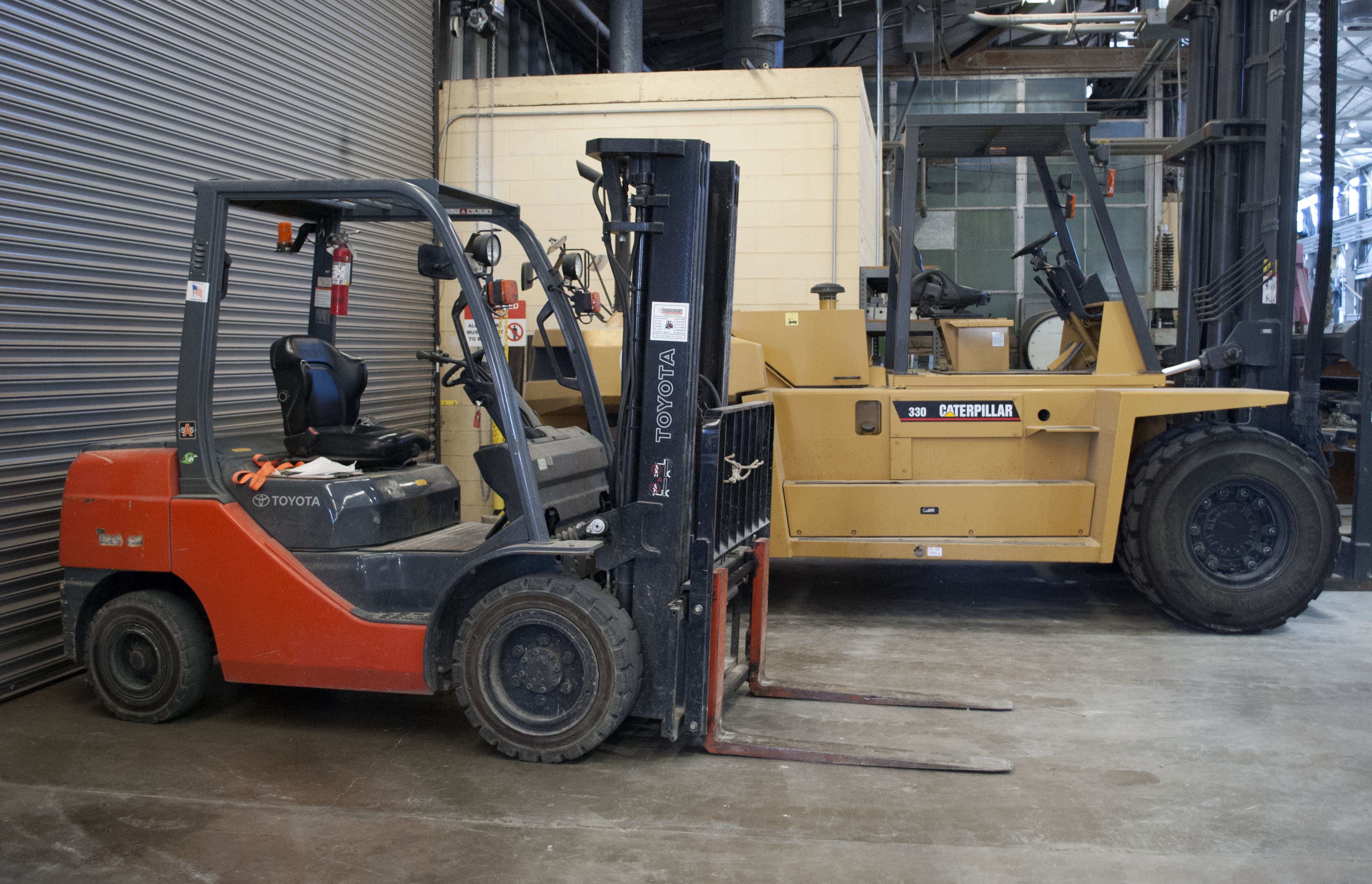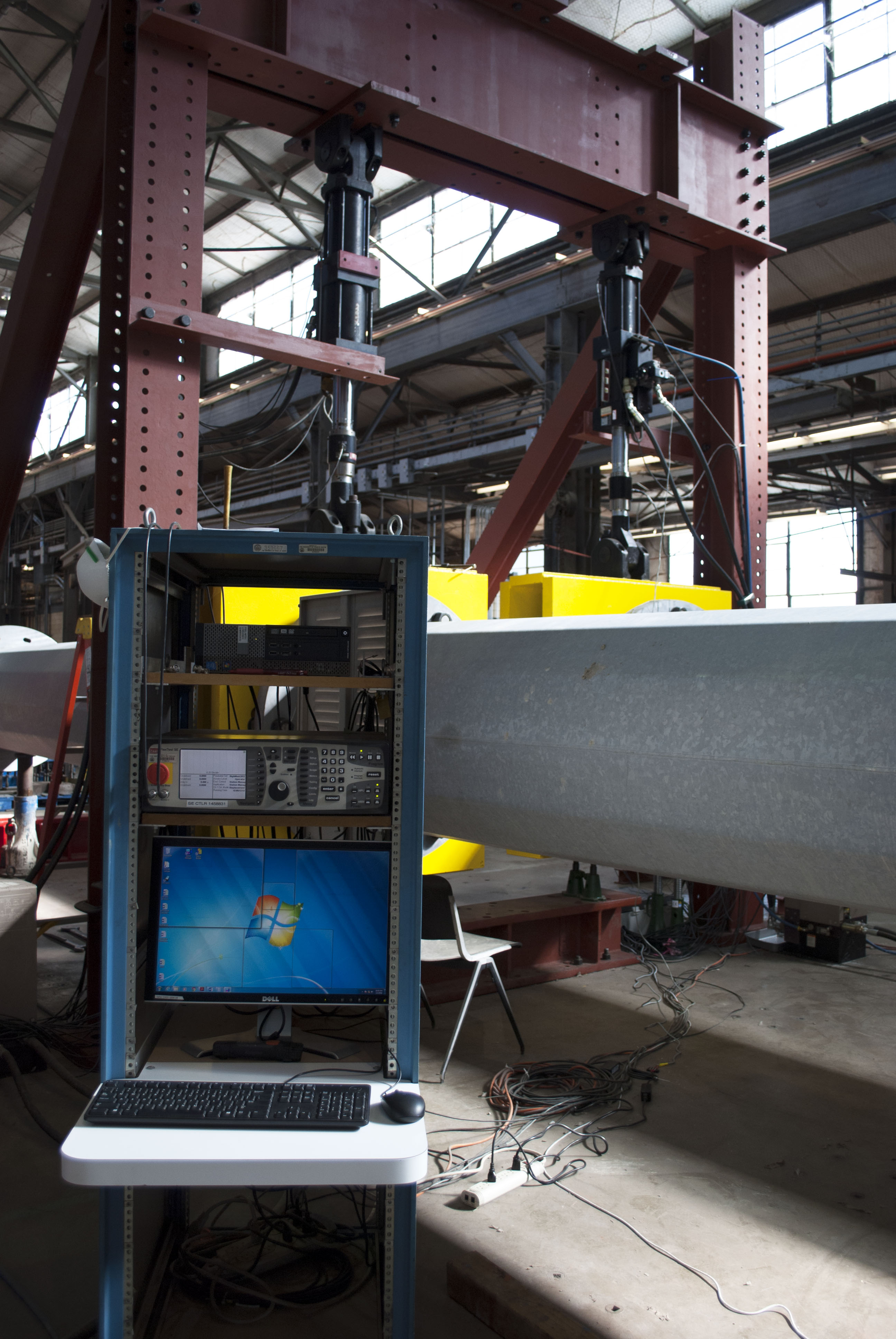FSEL maintains a variety of equipment to support our research and testing activities:
- Cranes
- Forklifts
- General Purpose Hydraulic Systems
- Servo-Controlled Hydraulic Systems
- Vision Systems
- Data Acquisition Systems
- Keysight (Agilent) Systems
- National Instruments Systems
- Campbell Scientific Systems
- Vision-based Measurement Systems
Cranes


Two overhead travelling cranes service the entire FSEL test floor and are independently capable of carrying 25 and 10 tons. The 25-ton crane has been an essential part of FSEL since the lab began operation and was outfitted with a new hoist and trolley in 2011. The 10-ton crane was added to the lab in 2007 to expand FSEL’s specimen lifting capacity. When used in tandem, the cranes have successfully transported specimens weighing as much as 31 tons. FSEL staff members are highly experienced in developing the rigging and lifting plans necessary to accomplish such a complicated operation safely.
Forklifts

FSEL has four forklifts. The largest forklift has a maximum lift capacity of 30,000 lb with a maximum reach height of 130 in. The second forklift has a capacity of 6,000 lb with a reach height of 187 in. The two remaining forklifts are electric and have a capacity of 4,500 lb and a reach height of 120 in. The two larger forklifts are operated by the technical staff and the two smaller forklifts are operated by staff and students who have completed FSEL’s internal training course.
General Purpose Hydraulics
For much of the structural testing performed at FSEL, loads are applied using hydraulic rams that are powered by small electric or pneumatic pump. FSEL has seven of these pumps that are either electrically or pneumatically powered and deliver up to 10,000 psi of pressure to the various rams. The pumps are used to supply pressure an assortment of single- and double-acting hydraulic rams at FSEL. The force capacity of these rams ranges from 1,000 lb to 4,500,000 lb. A summary of the hydraulic rams available at FSEL is provided in the table below.

Servo-Controlled Hydraulics

FSEL possess several MTS heavy-duty actuators that can be configured to apply forces and displacements to specimens in material, component, and large-scale subassembly tests. These actuators are fatigue-rated and therefore can be used in fatigue tests.
MTS 244.22 Hydraulic Actuator (1 unit):
- Double-acting actuator: can extend and retract
- Stroke: 10.0 in. dynamic and 10.6 in. static
- Force rating: 22.0 kips (tension and compression)
MTS 244.31 Hydraulic Actuator (2 units):
- Double-acting actuator: can both extend and retract
- Stroke: 10.0 in. dynamic and 10.4 in. static
- Force rating: 55.0 kips (tension and compression)
MTS 201.70 Hydraulic Actuator (3 units):
- Double-acting actuator: can both extend and retract
- Stroke: 30.0 in. both dynamic and static
- Force rating: 215.0 kips in tension and 330.0 kips in compression
For controlling these actuators, FSEL possess six MTS digital controllers that can be used to setup and automate structural, material, component, and large-scale subassembly tests under complex loading and displacement protocols. These controllers provide real-time closed-loop control, which is essential in fatigue testing.
MTS 407 Controller (2 units):
- Stand alone and automated modes
- Complete hydraulic pressure control
- Single-channel (can be interconnected to accommodate multi-channel testing)
- Digitally-supervised Proportional, Integral, Derivative, Feedforward (PIDF) servocontroller
- Function generation with frequencies in the range of 0.1 to 100 Hz
- Sampling rate of up to 20.48 kHz
MTS FlexTest SE Controller (2 units):
- Stand alone and automated modes
- Complete hydraulic pressure control
- Single-channel (can be interconnected to accommodate multiple-channel testing)
- Digitally-supervised Proportional, Integral, Derivative, Feedforward (PIDF) servocontroller
- Function generation with frequencies in the range of 0.01 to 400 Hz
- Sampling rate of up to 100 kHz
MTS FlexTest 60 Controller (1 unit):
- Automated mode only
- Complete hydraulic pressure control
- Eight control channels and 6 test stations
- Digitally-supervised Proportional, Integral, Derivative, Feedforward (PIDF) servocontroller
- Function generation with frequencies in the range of 0.01 to 600 Hz
- Sampling rate of up to 122.88 kHz
MTS FlexTest GT Controller (1 unit):
- Automated mode only
- Complete hydraulic pressure control
- Eight control channels and 4 test stations
- Digitally-supervised Proportional, Integral, Derivative, Feedforward (PIDF) servocontroller
- Function generation with frequencies in the range of 0.01 to 1000 Hz
- Sampling rate of up to 100 kHz
Vision System

FSEL has two Optotrack Certus HD vision-based measuring systems. These use high-speed, real-time digital photogrammetry and optical triangulation to track the precise 3D positions of targets over a large volume. The Certus HD system is used to determine the position and orientation of many moving objects by generating thousands of data points per second in real time. This system allows FSEL to observe and record surface displacements on various test specimens.
Data Acquisition Systems
FSEL has a variety of data acquisition systems, capable of handling the instrumentation in laboratory and field conditions. A brief description of the data acquisition equipment available at FSEL is provided below.
Indoor Data Acquisition Units
Indoor data acquisition at FSEL is primarily conducted using high-resolution Keysight (formerly Agilent) scanners and high-speed National Instrument units. Both systems are capable of making full- and quarter-bridge measurements. As a result, instruments such as load cells, linear potentiometers, pressure transducers, linear variable differential transformers (LVDTs), linear strain conversion transducers (LSCTs), and strain gages can be conveniently connected to these data acquisition systems and monitored. The total scanning capacity from all indoor data acquisition units at FSEL is over 880 channels.
Customized NI LabVIEW-based programs, developed by FSEL’s engineering staff, control the data acquisition process and provide real-time monitoring of data collected during testing. The ability to tailor the real-time data monitoring and analysis program to the experiment is a powerful feature of this system.
- High-Precision Keysight Scanners: 630 Channels
FSEL is equipped with five Keysight 34980A multifunction switch/measure units (scanners) that are customized for data acquisition. The scanners are supplemented by high-density multiplexers, providing a total scanning capacity of up to 140 channels for each scanner. Custom-made 10-channel terminal blocks, designed and fabricated by engineering staff at FSEL, are used to provide connectivity and circuit completion for the instruments that are connected to these scanners.
- High-Speed National Instruments SCXI-1000 Chassis: 96 Channels
FSEL is equipped with four SCXI-1000 chassis that are monitored by SCXI-1600 data acquisition and control modules. Data acquisition using these units can be conducted with scan rates up to 200 kHz. Each SCXI-1000 chassis includes 8-channel SCXI-1520 input modules, which provide a scanning capacity of 24 channels. Front mounting SCXI-1314 terminal blocks are used together with the input modules to make it possible to connect a variety of instruments for full-bridge and quarter-bride measurements.
- High-Speed National Instruments SCXI-1001 Chassis: 160 Channels
Two SCXI-1001 chassis, monitored by high-performance NI USB-6361 data acquisition devices, are available at FSEL. Data acquisition using these units can be conducted with scan rates up to 333 kHz. Each SCXI-1000 chassis includes 8-channel SCXI-1520 input modules, which provide a scanning capacity of up to 96 channels for each scanner. Front mounting SCXI-1314 terminal blocks are used together with the input modules to make it possible to connect a variety of instruments for full-bridge and quarter-bride measurements.
Outdoor/Indoor Data Acquisition Units
FSEL is equipped with high-resolution, high-speed data acquisition and control units manufactured by Campbell Scientific and National Instruments. These stand-alone units are optimized for field and long-term monitoring applications but can also provide real-time monitoring of data collected during testing. Therefore, they can be used in indoor testing applications when needed.
- Campbell Scientific CR3000 Microloggers
FSEL has five CR3000 Microloggers, which can conduct high-precision measurements as well as control operations. The units are capable of handling bridge-circuits, voltage outputs, thermocouples, and pulse/frequency signals with scan rates of up to 100 Hz. The low power consumption of these units enables them to operate for extended periods when their batteries are recharged with solar panels. Multiple CR3000s can be configured as a network or each unit can be deployed individually.
A variety of accessories and interface devices are available at FSEL to enhance the capabilities of these units. These accessories include:
i. AM 16/32, AM 16/32B, and AM 416 relay multiplexers, to increase the number of channels measured,
ii. AVW 200 and AVW 206 vibrating wire interface analyzers, to provide the capability of making measurements from vibrating wire instruments,
iii. RF 401 spread spectrum radios, to enable wireless communications in field applications, and
iv. Airlink Raven XT cellular network modems, to provide the remote monitoring capability.
Each CR3000 can make direct measurements from 14 instruments. When needed, thirty-six 32-channel relay multiplexers are available at FSEL, which can significantly increase the scanning capability of these units.
- Campbell Scientific CR5000 data loggers
FSEL has six CR5000 data loggers, which can conduct high-precision measurements as well as control operations. The units are capable of handling bridge-circuits, voltage outputs, thermocouples, and pulse/frequency signals with scan rates of up to 1.67 kHz. The low power consumption of these units enables them to operate for extended periods when their batteries are recharged with solar panels.
All accessories mentioned above for CR3000s are also compatible with CR5000s and can therefore be used to enhance the capabilities of these units. Each CR3000 can make direct measurements from 20 instruments. When needed, the relay multiplexers available at FSEL can be used to increase the scanning capability.
- National Instruments Wireless Network Devices
FSEL is equipped with a variety of wireless network devices, which provide enhanced capabilities for structural health monitoring applications. These devices include:
i. NI WSN-3214 strain gage/ bridge completion nodes (16 Ea.)
ii. NI WSN-3202 analog input nodes (8 Ea.)
iii. NI WSN-3212 thermocouple input nodes (2 Ea.)
iv. NI WSN-3212 thermocouple input nodes (2 Ea.)
v. NI WSN-9791 Ethernet gateway (6 Ea.)
vi. NI 9792 programmable gateway (2 Ea.)